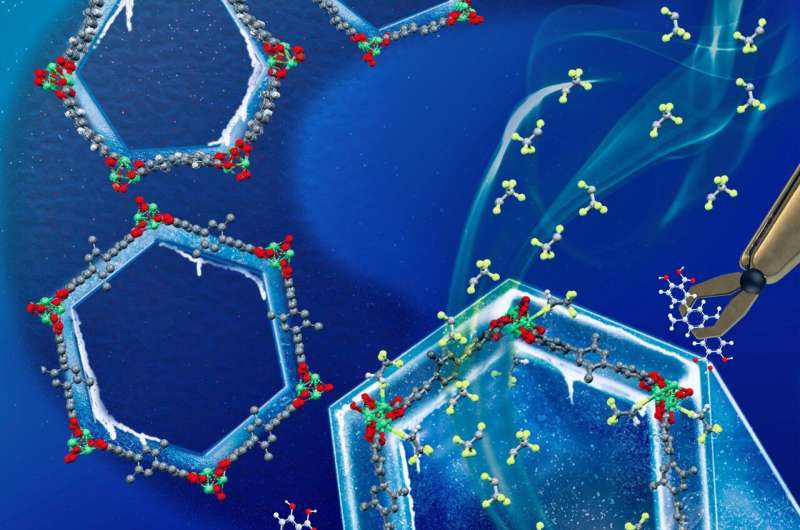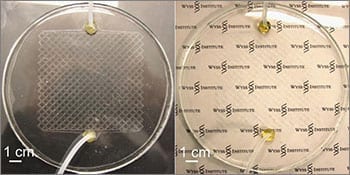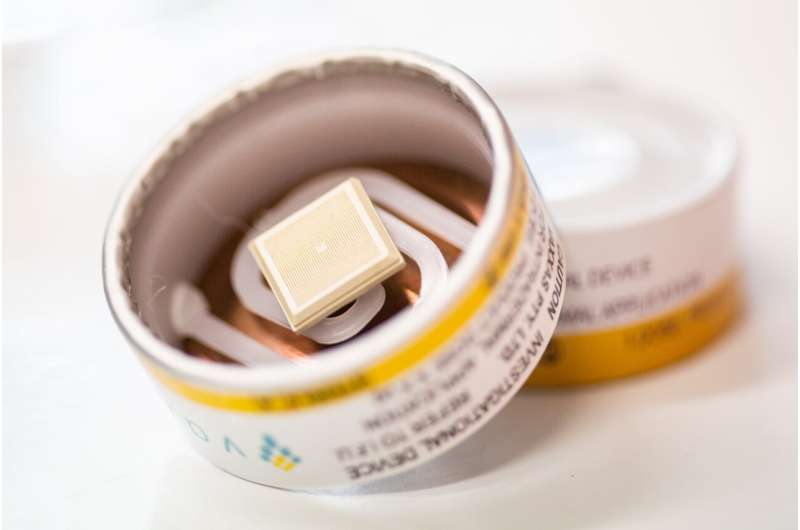
In adsorption cooling systems, molecules of vapor refrigerant (the guest) are adsorbed in the nanopores of a solid material (the host). Motkuri and his collaborators have studied how changing the geometry of the nanopores (pore engineering) and the speed of host-guest chemical interactions affect the cooling capacity and energy efficiency of adsorption cooling systems.
(Image by Rose Perry | Pacific Northwest National Laboratory)
Ensemble approach offers path to energy-saving air-conditioning
When the heat of summer hits, air conditioners turn on and energy demand skyrockets, straining the grid. In a warmer world, more efficient cooling options will play an important role in curbing the increase of cooling-related energy demands. This will be particularly true for the nearly 80 percent of the global population living in countries surrounding the equator, where even small temperature increases could be life-threatening.
New research from Pacific Northwest National Laboratory (PNNL) provides a roadmap outlining how more efficient cooling systems are feasible with development and support from industry. The invited research study appeared in the journal, Accounts of Chemical Research.
“Right now, this is fundamental science. However, this could be a game changer for industry,” said Radha Motkuri, PNNL chemical engineer and corresponding author.
The chemistry of cool
Motkuri and the research team examined one approach that could offer significant energy savings: adsorption cooling. These systems can run on small amounts of waste heat from a building or industrial plant to power reactions between a vapor refrigerant and a solid material.
“Once we input power the first time, that’s it,” explained Motkuri. “Then, the system keeps on cycling—adsorption, desorption, adsorption, desorption—with very little power input.”
This is in direct contrast to conventional cooling systems that use a compressor and require regular inputs of energy.
Tuning an adsorption cooling system to achieve ideal cooling capacity and energy efficiency requires understanding the complex chemistry between the system’s vapor refrigerant, called the guest, and solid absorbent material, called the host. Motkuri and his collaborators dug into these details—adjusting the pore geometry of the solid sorbent, the speed of chemical interactions, and even the impact of tiny defects in the solid material—to understand how they affect the entire system. Recently, the team was invited to compile their work into an efficient ensemble that can help developers in the cooling industry trying to meet the demand for more energy efficient options.
“Refrigerant-based adsorption cooling eliminates the major cost, efficiency, and reliability issues that have limited adoption of current water-based adsorption cooling systems in commercial and residential buildings,” said Pete McGrail, Laboratory fellow and chemical engineer who led PNNL’s adsorption cooling effort for several years. “This journal article represents a synopsis of years of research into novel sorbent-refrigerant pairs that significantly advanced adsorption cooling technology.”
Environmentally conscious components
With global heatwaves on the rise and cooling-related energy demands expected to triple by 2050, there is a push for cooling systems with smaller environmental footprints. In addition to more energy efficient systems, this includes changing standards for refrigerants.
Commonly used hydrofluorocarbon refrigerants will be phased out in the next few years in favor of more environmentally friendly hydrofluoro-olefins (HFOs). HFOs have a global warming potential near zero, which means that emissions of HFOs hold much less relative heat in the atmosphere compared to emissions of hydrofluorocarbon refrigerants.
Aware of this transition, Motkuri and his collaborators conducted their testing using the readily available, inexpensive hydrofluorocarbon refrigerant, R-134a. This hydrofluorocarbon refrigerant has a high global warming potential, but a similar chemical behavior to HFOs, which makes it a suitable alternative for studying the molecular interactions of adsorption cooling systems that will use HFOs in the future. The researchers look forward to integrating HFOs in future adsorption cooling research as the next step in green cooling systems.
Original Article: Greener Air-Conditioning for a Warmer World
More from: Pacific Northwest National Laboratory
The Latest Updates from Bing News & Google News
Go deeper with Bing News on:
Green cooling systems
- Greenenergybreaks - Vision Marine Technologies Inc. (NASDAQ: VMAR) Announces Filing Of Patent For Cooling System Control In Electric Marine Vessel
The application addresses the unique challenges of designing and operating electric propulsion systems in marine environments.“Cooling efficiency stems from ... working to shape the future of the ...
- How Much Does a Green Roof Cost? (2024 Guide)
Learn More › Highlights A green roof cost averages $22,000, though some homeowners spend between $12,000 and $40,000. The main cost factors for installing a green roof include the roof type ...
- Introducing 'cooling' green parks to Indian cities
Science X is a network of high quality websites with most complete and comprehensive daily coverage of the full sweep of science, technology, and medicine news ...
- Green Attics Ensures Optimal Home Comfort and Energy Efficiency with Professional Insulation & HVAC Services in DFW
With a customer-centric approach, Green Attics offers a free energy audit to make Texas homes more energy-efficient while improving indoor air quality.
- Virginia Green Travel Alliance names Old Bust Head 'Green Brewery of the Year'
Old Bust Head Brewing Company, an independent, solar-powered microbrewery in Vint Hill, has been awarded the 2024 "Green Brewery of the Year" and a “People’s Choice Award” by the Virginia Green Travel ...
Go deeper with Google Headlines on:
Green cooling systems
[google_news title=”” keyword=”green cooling systems” num_posts=”5″ blurb_length=”0″ show_thumb=”left”]
Go deeper with Bing News on:
Adsorption cooling
- What to Do if Your Air Conditioner Is Not Cooling Your Space
The appliance circulates air, but nothing refreshingly chill. My air conditioner is not cooling at all. How do I fix it? A: It’s the last thing you want on a sweltering summer’s day ...
- The 12 Best Cooling Pillows of 2024
Hot sleepers, don't worry, there are solutions. In addition to cooling sheets to put on your bed, you can also get cooling pillows. Updating to a cooling pillow will give you a much different ...
- Best Laptop Cooling Pads 2024: These Coolers Actually Work
Cooling pads typically combine fans with ventilation slots or a mesh surface, optimizing airflow to keep your laptop at peak performance. This not only helps your laptop run smoother but can also ...
- Best Laptop Cooling Pads in 2024
Whether it is a cooling pad to cool the laptop or to help rest it comfortably on a lap for long periods, here is a helpful guide Does your new laptop act a bit more sluggish or make more noise ...
- Best Quiet CPU Cooling Options for 2024
Stop your PC from sounding like a jet engine with these carefully selected cooling solutions for every budget. With the increasing power consumption of high-end processors, the need for premium ...
Go deeper with Google Headlines on:
Adsorption cooling
[google_news title=”” keyword=”adsorption cooling” num_posts=”5″ blurb_length=”0″ show_thumb=”left”]










